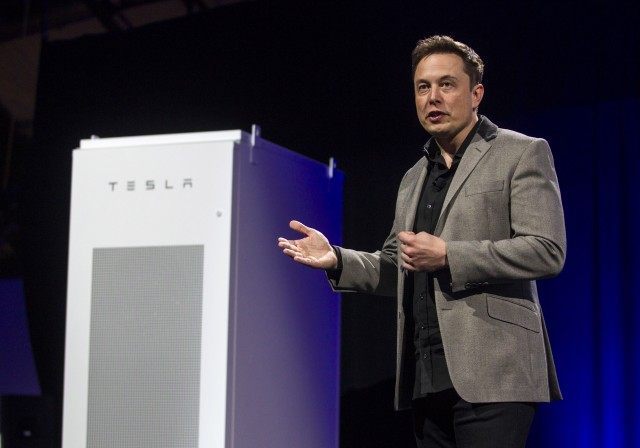When Tesla Motors Inc. CEO Elon Musk unveiled a line of home and commercial battery packs a week ago, he said Tesla was “trying to change the fundamental energy infrastructure of the world.” Although the system Musk announced was better than the competition, the cost was assumed to be too expensive except for home solar systems. But now it turns out that Tesla’s new batteries do not even make economic sense to back-up rooftop solar systems–at least not yet.
Tesla said that “Powerwall” batteries would be offered in two sizes; a 7-kilowatt-hour (kWh) configuration for daily use and a 10 kWh for the occasional interruption of an electrical power grid. My estimate is that houses pull about 2 to 3 kWh per hour, so a consumer who wants 3 hours of stand-by power would need to choose which Powerwall is appropriate depending on the size of his or her home.
But as Breitbart News pointed out last week, the economics of the 7 kWh lithium Powerwall offered at a cost of $3,500 compare unfavorably to buying 4 305-AC deep cycle 6-volt batteries at a cost of $180 each, or $720 for the set. For the 10kWh size Powerwall priced at $5,000, the economics seem much worse.
When Tesla spokeswoman, Khobi Brooklyn, e-mailed that both sizes of the Powerwall battery would be available in the U.S. from distributors by late summer, it seemed safe to assume that Tesla would rely on a built-in launch market to sell 7 kWh Powerwalls through SolarCity, the biggest installer of roof-top residential solar panels. With Musk as SolarCity’s CEO, the 7kWh battery seemed an easy sell to provide daily continuing power to solar-equipped homes after the sun goes down.
But SiliconValley.com just reported that SolarCity spokesman Jonathan Bass said that the 7 kWh battery “doesn’t really make financial sense” because California and other states allow most roof-top solar customers to sell any extra power they generate back to the electric grid at a big premium to what those customers would pay to buy grid power.
SolarCity says they will offer the bigger 10 kWh Powerwall for rooftop solar systems at a price all-in at $7,140, or $5,000 up front, with the customer paying some price for a nine-year battery lease for their system. But with the 10 kWh Powerwall designed for only 50 charging cycles per year, the battery cannot be used for daily power in the evening.
SiliconValley.com also worries that even as a backup power source, the 10 kWh Powerwall will only put out just 2 kilowatts of continuous power. They believe that could “pretty much be maxed out by a single vacuum cleaner, hair drier, microwave oven or a clothes iron.” In winter, “[t]he battery isn’t powerful enough to operate a pair of space heaters.”
Brian Warshay, an energy-smart-technologies analyst with Bloomberg New Energy Finance, commented that to provide the same 16 kilowatts of continuous power as a $3,700 off-the-shelf Generac generator at Home Depot, a homeowner would need to buy eight stacked Tesla batteries at a cost of $40,000 and sign a nine-year lease with Tesla. Warshay believes that Powerwalls are “a luxury good–really cool to have–but I don’t see an economic argument.”
Tesla may still have a business opportunity to sell its batteries to big companies, like Walmart and Amazon, or to electric utilities like Southern California Electric and Pacific Gas and Electric. Many states charge premium prices for commercial electricity usage during peak power of the day that can be 4 times as expensive as non-peak. With the right subsidies and electricity pricing, Tesla’s Powerwalls may have a competitive advantage to existing battery and generator back-up power for storing energy at off-peak late evening hours and making it available during on-peak daytime hours.
Tesla’s Powerwalls are an important technological advancement, but they do not have the type of massively positive economic advantages necessary to spark a disruptive boom for battery back-ups. With Tesla’s $5 billion Nevada Giga-factory scheduled to begin shipments next year, the cost for building Powerwalls needs to fall substantially for the product to be an economic success at changing the “fundamental energy infrastructure of the world.”

COMMENTS
Please let us know if you're having issues with commenting.